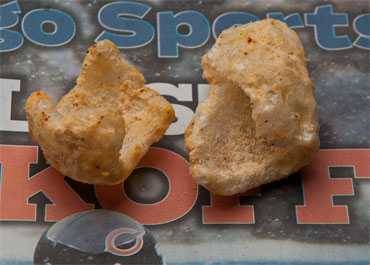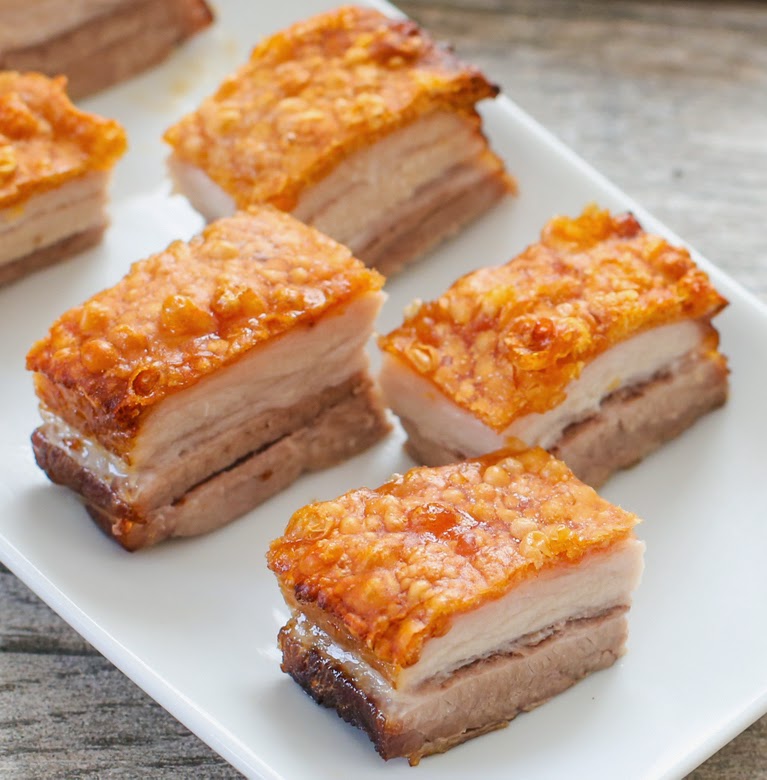고정 헤더 영역
상세 컨텐츠
본문


My sous and I have been running a few experiments trying to reheat cubes of pork belly for (mock) service and retaining or recreating perfect crackling. We have reheated in sauce and blasted in the salamander, thrown it on the grill skin side down etc. While the meat comes out extremely nice and succulent, we can't seem to get the crackling right. The salamander, for instance, crisps the skin up again, but it becomes very chewy.On the same note I'm still wondering (as in a former thread months ago) how some of you guys keep tender ready for service over a typical period of, say, 2 1/2 hours or so, without overcooking the inside and losing the pink centre, for example in a prime rib roast. I might add that I don't have a convection oven in my kitchen, so for holding anything at the right temperature I have to resort to my steam table. Great for sauces, mash, stews etc., but most cuts of meat will suffer. Perhaps a heat lamp?
Although I can't imagine this working for an extended period of time. Or are you all that busy all the time that you just slice and plate and never hold???Thanks for your ideas!Cheers,Recky. From what you describe it sounds like you have the wrong cut for what you're doing.' Cracklings' are from the skin. This happens while pit grilling an entire hog at once. The skin crisps. In stores we buy cracklings in bags.
I believe they are deep fried skin.I don't believe you can get that texture with the belly meat.Have you tied torching it rather then the salamander?The best way to hold a large cut of meat for long service time is to cook the roast rare, and finish to order. You may have to stagger cooking multiple during service. Recky, you're right, the term 'crackling' can be taken different ways. For me, as a Californian, I think of cracklings as fried skin, which is a different process in its self.
I used to work at a New Orleans style restaurant and 'cracklings' were large diced, salted and confit pork belly that we fried on order and tossed in seasoned salt. The skin was never as crispy as one might optimally want, but delicious nonetheless.However, I have also roasted suckling pigs with vegetables, stock (to come just half way up) and herbs in a covered roasting pan until almost cooked and then when the pig was almost finished, removed the foil top. The skin was then exposed to heat which dried it out.the most important part to crispy skin. Once the pig was cooked through, and the skin was brown and dried out we would let the pig cool, pull out all the bones and then press overnight. After it was cool we would then portion the pig into pieces.
On the order, the pig portion would go into the salamander, skin side up, just to melt the gelatin and allow the juices leave the skin. Pat the skin dry and then sear in a cast iron pan. The skin came out crispy and the meat was tender. Recky, you're right, the term 'crackling' can be taken different ways. For me, as a Californian, I think of cracklings as fried skin, which is a different process in its self.
I used to work at a New Orleans style restaurant and 'cracklings' were large diced, salted and confit pork belly that we fried on order and tossed in seasoned salt. The skin was never as crispy as one might optimally want, but delicious nonetheless.However, I have also roasted suckling pigs with vegetables, stock (to come just half way up) and herbs in a covered roasting pan until almost cooked and then when the pig was almost finished, removed the foil top. The skin was then exposed to heat which dried it out.the most important part to crispy skin. Once the pig was cooked through, and the skin was brown and dried out we would let the pig cool, pull out all the bones and then press overnight. After it was cool we would then portion the pig into pieces. On the order, the pig portion would go into the salamander, skin side up, just to melt the gelatin and allow the juices leave the skin. Pat the skin dry and then sear in a cast iron pan.
The skin came out crispy and the meat was tender. We take pork belly and cut it into 1 cm by 1.5 cm cubes, salt them and let them sit overnight.
We then warm up some canola oil mixed with lard and add the pork, and braise for maybe an hour and a half in the oven at 325. The pork should then be cooled to room temp in the fat. After its cool, then strain and lay on a sheet pan with parchment paper, cool in the walk in. From there you can fry in 400°F (205°c) oil and season as you wish.
They skin isnt snap-crackly, but its crispy and the fat is melty and the meat is tender. I'm curently slow cooking a belly at the moment. I let it braise in wine stock and veg for 3 hours at 120 Celsius covered tightly with paper and foil then remove the foil and turn the oven up to 140 Celsius for another hour. When its nice a tender ill remove it and let it cool in the juices. After I will press it over night and then portion to 170 grams.For service I put a bit of oil in a pan then the belly portion skin side up and sprinkle the skin with sea salt.
That then goes in the oven at 180 Celsius for 20 minutes I then bring it out and let it rest.When it comes time to plate I heat up a clean pan with fresh oil when its hot the belly goes in skin side down and the crackle is instant. On the same note I'm still wondering (as in a former thread months ago) how some of you guys keep tender ready for service over a typical period of, say, 2 1/2 hours or so, without overcooking the inside and losing the pink centre, for example in a prime rib roast. I might add that I don't have a convection oven in my kitchen, so for holding anything at the right temperature I have to resort to my steam table. Great for sauces, mash, stews etc., but most cuts of meat will suffer. Perhaps a heat lamp?
Although I can't imagine this working for an extended period of time. Or are you all that busy all the time that you just slice and plate and never hold??? You are 100% correct.
How To Reheat Pork Cracklings

I even tried today after being unsuccessful for nearly 40 years at trying everything under the sun. The best thing is to just keep in a very dry, warm spot in the kitchen or a hot box as another suggest like the Cuban joints in Miami do. I was born in Miami and been cooking lechon and chicharrones for over 4 decades and have found no way to return to fresh made. Today I went to a great Dominican place called Pollo TIpico in Davie and got a whole piece, the meat and skin.
Got home separated the skin from the meat and put a little piece of skin in a hot toaster oven and it went from awesome to the garbage can. The skin got rubbery, the fat got a weird consistency and all I can say is yucky. I guess I just have to get them fresh.




